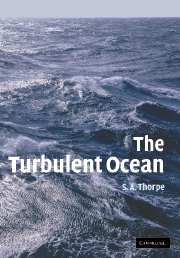Book contents
- Frontmatter
- Contents
- Preface
- Structure and résumé
- Acknowledgements
- 1 Heat, buoyancy, instability and turbulence
- 2 Neutral stability: internal waves
- 3 Instability and transition to turbulence in stratified shear flows
- 4 Convective instabilities
- 5 Instability and breaking of internal waves in mid-water
- 6 The measurement of turbulence and mixing
- 7 Fine-structure, transient-structures, and turbulence in the pycnocline
- 8 The benthic boundary layer
- 9 The upper ocean boundary layer
- 10 Shallow seas
- 11 Boundary layers on beaches and submarine slopes
- 12 Topographically related turbulence
- 13 Large-scale waves, eddies and dispersion
- 14 Epilogue
- Appendices
- References
- Index of laboratory experiments
- Subject index
- Plate section
8 - The benthic boundary layer
Published online by Cambridge University Press: 05 June 2012
- Frontmatter
- Contents
- Preface
- Structure and résumé
- Acknowledgements
- 1 Heat, buoyancy, instability and turbulence
- 2 Neutral stability: internal waves
- 3 Instability and transition to turbulence in stratified shear flows
- 4 Convective instabilities
- 5 Instability and breaking of internal waves in mid-water
- 6 The measurement of turbulence and mixing
- 7 Fine-structure, transient-structures, and turbulence in the pycnocline
- 8 The benthic boundary layer
- 9 The upper ocean boundary layer
- 10 Shallow seas
- 11 Boundary layers on beaches and submarine slopes
- 12 Topographically related turbulence
- 13 Large-scale waves, eddies and dispersion
- 14 Epilogue
- Appendices
- References
- Index of laboratory experiments
- Subject index
- Plate section
Summary
Introduction
The ‘benthic’ boundary layer (bbl) is the layer overlying the deep ocean seabed within which the mean speed of the overlying water is reduced from its ambient value distant from the boundary to zero at the seabed (or nearly to zero relative to the solid Earth if the seabed is covered by mobile and moving sediment particles). In shallow water the layer, discussed in Chapter 10, is usually referred to as the bottom boundary layer, but many (not all) of its properties are similar, if not identical, to those of the bbl. Turbulence in the bbl is sustained by shear resulting from the stress exerted on the seabed by the water flowing over it, and by flow separation over bottom roughness. The stress can equally be thought of as that exerted by the seabed on the water in reducing its speed to zero.
Because of its importance in the understanding of flow over aircraft wings and of the variation in wind speed and gustiness near the ground, the nature of turbulence near rigid boundaries has been the subject of intensive investigation since the early years of the twentieth century, through both laboratory experiments and measurements in the atmospheric boundary layer over land, supplemented in more recent years by numerical simulations. Much of what is know about the structure of turbulence in such boundary layers comes from these extensive and comprehensive studies.
- Type
- Chapter
- Information
- The Turbulent Ocean , pp. 213 - 227Publisher: Cambridge University PressPrint publication year: 2005



